How do you tell a story that people know, or maybe just think they know?
Each of the newsrooms featured here this week took on that question in different ways.
In Los Angeles, the LA Times made a game to go with project on sea level rise. The Chico (California) Enterprise-Record made a podcast to accompany its coverage of the deadly smoke that came with the recent Camp Fire. And in Colorado, the Canyon Courier looked back at the Columbine school shooting 20 years later through the lessons learned and the changes it led to.
What’s your local newsroom working on? Share the work that you’re proud of, and I’ll reach out if we decide to feature it. (Also, we don’t just want to highlight work from print/online. If you’re an online-only shop, radio or TV, send us your stuff!)
[the_ad id=”667826″]
All the answers shared here came through a Google form and have been edited for length and clarity.
“… We realized: Why not create a game?” — Rosanna Xia, environment reporter, Los Angeles Times
Newsroom: Los Angeles Times
Newsroom size: About 525
Project: California against the sea and The ocean game
Who worked on this project: Rosanna Xia, reporter; Ben Muessig, editor; game designers Swetha Kannan and Terry Castleman; Carolyn Cole, photographer, plus staff photographers and editors.
How did you make this project happen?
As I started looking into how cities up and down the coast were confronting sea level rise, it became clear that the people and details may have been different in each place – but the stakes and existential questions were the same. Over and over again, I heard people argue over what to do. So my editor Ben Muessig and I brainstormed how to get people to truly see the finite number of choices – and the costs and tradeoffs inherent in every one of these choices. In addition to explaining these stakes clearly in a story that took you to different places in California, we realized: Why not create a game? We holed up in a conference room for days and mapped out the decision tree with a gazillion sticky notes. We pulled in graphics reporter Swetha Kannan, who had done a similar decision-based game for an investigation into how dishonest cops were protected by the system, and Terry Castleman, an engineer who has worked on a number of our internal apps. By simplifying the stakes of the issue and putting the reader in charge of making these choices, the game helped explain the costs and tradeoffs of each decision – and why this issue is so complex and challenging. Using gaming logic and creative design, Swetha and Terry allowed readers to experience how each choice might affect the coastline.
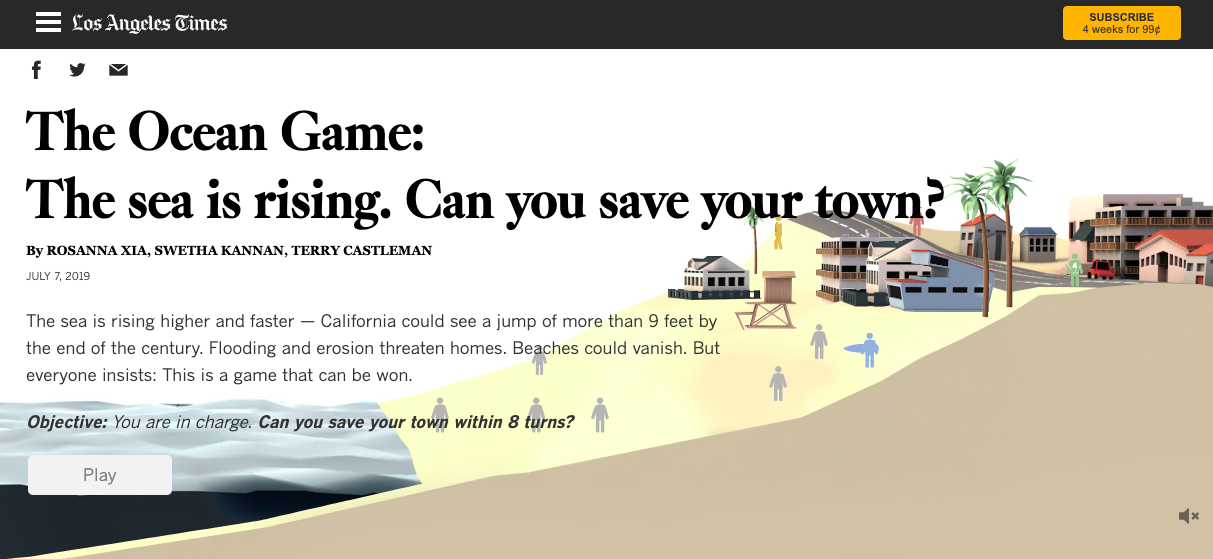
The Los Angeles Times created a game to help readers understand sea level rise. (Screenshot)
Related training: The Secret of Making Complicated Facts Easy Reading
What did you learn?
Everyone I talked to seemed to acknowledge the problem, but the “what do you do part” has been paralyzing communities up and down the coast. If you talk to experts, coastal scientists, planners … they all will end up saying that you only have so many choices to adapt to the rising sea: One is to defend the coastline. Another option is to add sand. The third option is to relocate and migrate inland with the water. These choices are grim and all have their consequences. We learned that this issue is grounded in facts and science, but overwhelmed by emotional attachments to place and home. We learned that explaining an issue as complex as this one was effective when we gave readers the chance to make these emotional and strategic decisions themselves.
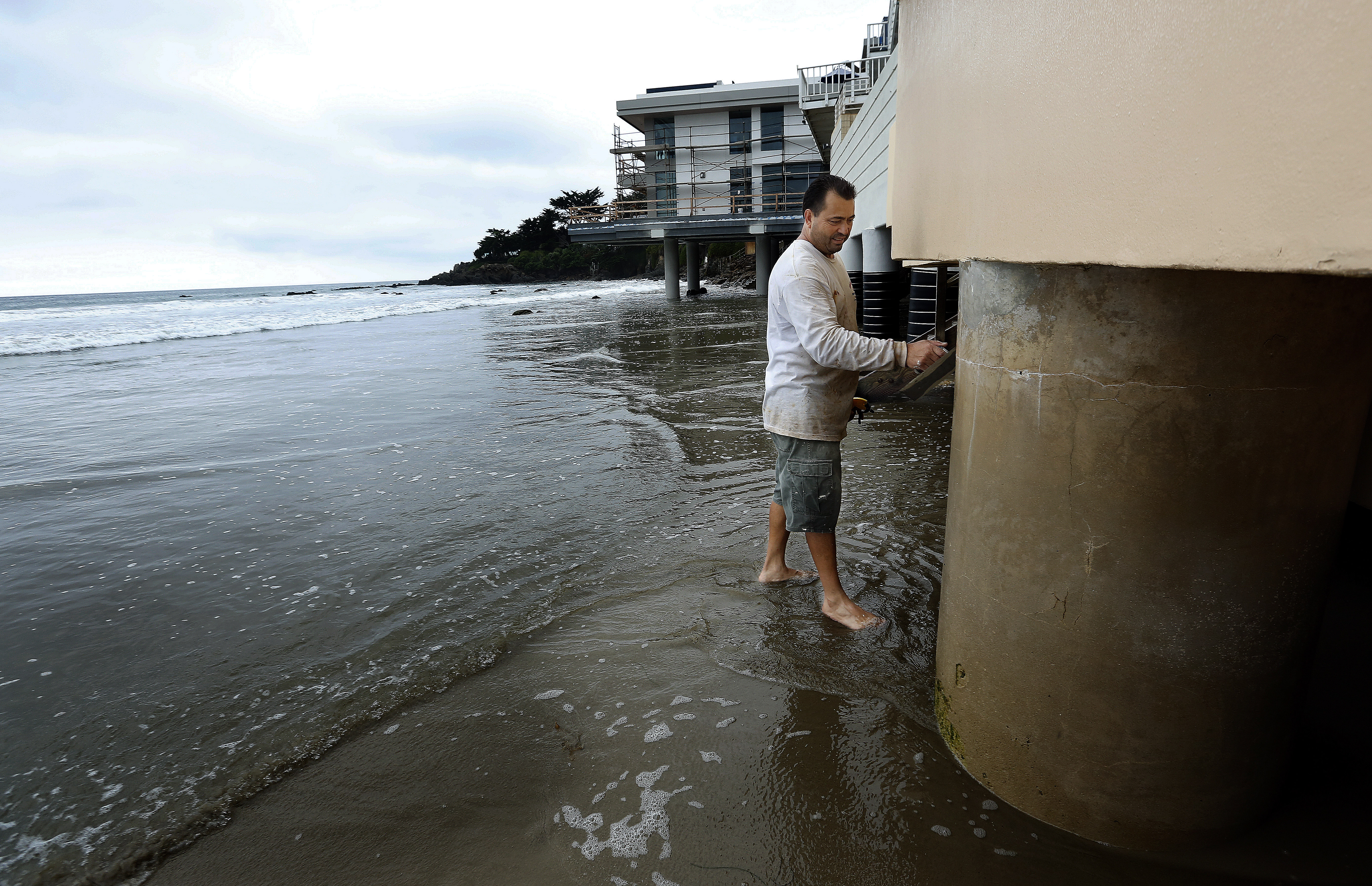
General contractor Alex Peris applies a coat of plaster to a support column of a home at Broad Beach in Malibu, that suffered water damage from the ocean on October 18, 2015. (Mel Melcon/Los Angeles Times)
How can other local newsrooms do work like this?
We were lucky enough to have a robust team to do work like this, with talented folks from graphics, design and software engineering. But, at its core, this story and interactive game were powered by a fundamental understanding of the issue – understanding the stakes and nuances to a point where we could break it down simply and provide an alternative form of explanatory reporting. Other newsrooms have also explored these new ways of explaining complex issues, and we’re excited and inspired by how many journalists are thinking beyond the conventional ways of storytelling.
“… Once you’re in the thick of it, you just keep slogging through.” — Robin Epley, reporter, Chico Enterprise-Record
Newsroom: Chico (California) Enterprise-Record
Newsroom size: About nine.
Project: Inhaled, a series and podcast
Who worked on this: Robin Epley, reporter; Dan Reidel, editor; Christine Rushton, digital editor.
How did you make this series and podcast happen?
“Inhaled” came about because I wanted to do a big series, so I pitched it on day two of my new job back in early January and slowly worked on it over the course of months. It was a lot of work on nights and weekends, stealing days from my full-time job and coming in on weekends. I was calling sources when I could between other interviews and doing research in quiet moments. All that changed in April when my mom died suddenly, so I went from “busy” to “manic.” It only pushed back the deadline by a month though, and I’m grateful to my editors for allowing me space and time to deal with the blow of losing my mom. So, somehow, between early April and now, I’ve managed to plan and host a huge funeral, deal with end-of-life paperwork and family duties, write this series, record it, continue doing my freelance work, and finally move into my own apartment after six (!) months of searching in Chico’s insane housing market after the fire and living in a co-worker’s spare bedroom. I’m glad “Inhaled” is finally coming to a close, but even when I look back at all of that, I really don’t know how I did it.

Dutch Bros. employee Brittany Bauer advertises an opportunity to help Camp Fire victims on their face masks. (Carin Dorghalli/ Enterprise-Record)
What did you learn?
I learned a lot about myself, as cliché as that sounds. If you’d’ve told me what I would have had to do to make this happen, I would have run as fast as I could in the opposite direction. But once you’re in the thick of it, you just keep slogging through.
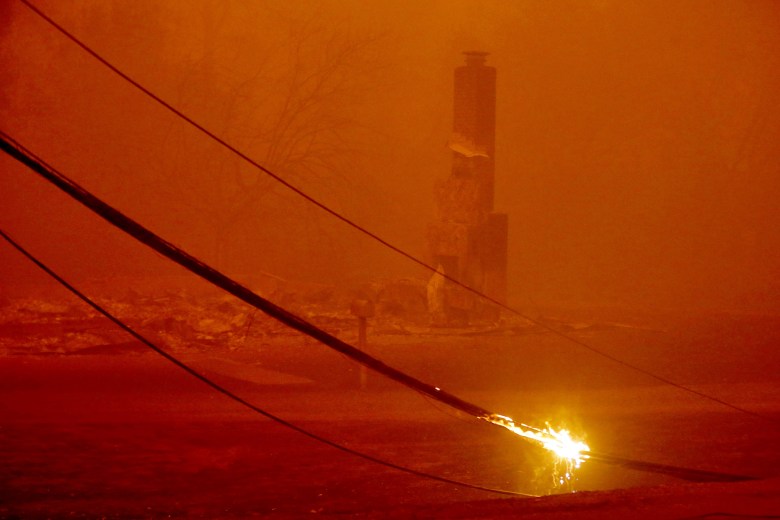
A power cable is burned as a chimney of a destroyed house is barely visible during the Camp Fire on Honey Run Road in Paradise, Calif., on Friday, Nov. 9, 2018. (Ray Chavez/Bay Area News Group)
How can other local newsrooms do work like this?
I suggest using your hobbies and your talents to find inspiration. I really like podcasts, so I made “Inhaled” not just a newspaper series (as was expected of me,) but I gave it an audio component that spoke to my personal, creative side, too. There’s so many ways out there to tell stories, so think about what you like to see and hear and then head in that direction. And bosses: You can support your newsroom by giving them the freedom to cover topics they wouldn’t normally, and trust them to do it ways you don’t normally see. I’m a city politics reporter but this project is about health and science and the environment. On top of that, the E-R has never done a serial podcast before. My editor, Mike Wolcott, gave me free rein and it’s paid off for not just us, but for the whole newsroom. We’re all buzzing with series ideas and big plans.
[the_ad id=”667878″]
“… Think about what makes the event meaningful and how can you cover it in a way that hasn’t been covered before.” — Michael Hicks, editor, Evergreen Newspapers
Newsroom: Canyon Courier
Newsroom size: Six
Project: Columbine anniversary coverage
Who worked on this: Deborah Swearingen, reporter; Corinne Westeman, reporter; Sara Hertwig, photo editor; Deb Hurley Brobst, news editor; Michael Hicks, design and editing.
How did you make this story/series happen?
April 20, 2019, marked 20 years since one of the most tragic incidents in not just our neighboring community but the nation as a whole — the Columbine High School tragedy. For us at Evergreen Newspapers, it may have been a little more meaningful. You see, until Dec. 27, 2018, we published the Columbine Courier. That day, however, would be our last issue — four months before the anniversary came up. But we still cover the area from time to time. We’re still a part of Jefferson County. So we made the decision to put a four-page section within the Canyon Courier edition on April 17, 2019, to cover lessons learned from that tragic day 20 years ago.
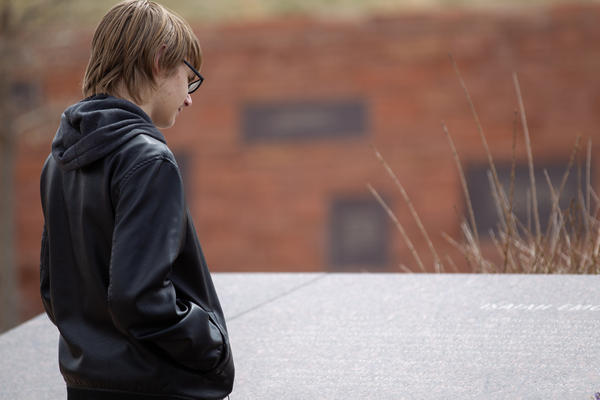
Davin Stafford, 16, reads plaques at the Columbine Memorial with the names of those lost on that tragic day. (Photo by Sara Hertwig/Evergreen Newspapers)
Related training: The Secret of Making Complicated Facts Easy Reading
What did you learn?
What we found out in putting that section together, and even more so since that moment, is that the school and community came together, but that no matter whether it’s Parkland or Sandy Hook, whenever a school shooting happens one of the first things people talk about is Columbine. Security measures have improved, but there’s always room to grow. The tragedy itself has taken a toll on those who were involved. It didn’t help that there was a scare just days before the anniversary that left the community on edge.
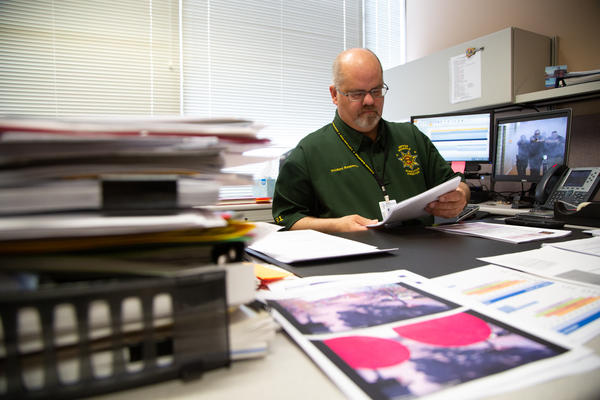
John McDonald, Executive Director of Security and Emergency Management for Jeffco Public Schools, works with community partners to create safe environments in the district. (Photo by Sara Hertwig/Evergreen Newspapers)
How can other local newsrooms do work like this?
Think a bit outside of the box. Instead of just reporting on the anniversary or event at hand, think about what makes the event meaningful and how can you cover it in a way that hasn’t been covered before. We talked to security officers, former teachers, relatives of loved ones who were victims on that tragic day. Then we found a way to incorporate it in our paper, yet make it a four-page pullout so that people could keep it as a keepsake opposite of the paper itself.







